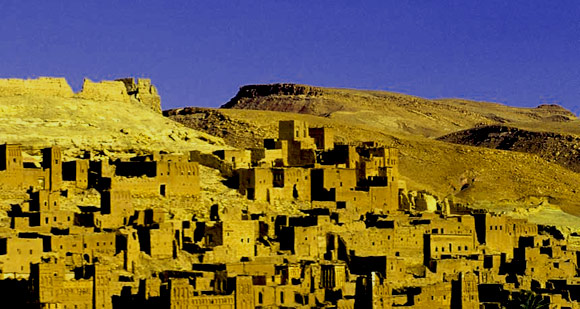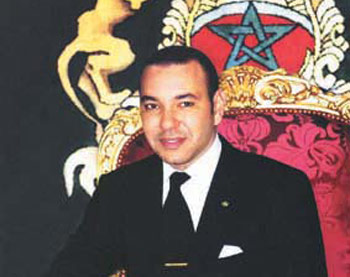Morocco History: Centuries Under Romans to Morocco of Mohamed VI
Morocco Top Stories
Brief Outline of Relevant Moroccan History to 1999
Evidence of human habitation by ancestors of the present Berbers in Morocco goes back at least 8,000 years, though historical records do not begin until the 12th century BC with the coming of Phoenician trading settlements.

Brief Outline of Relevant Moroccan History to 1999
Evidence of human habitation by ancestors of the present Berbers in Morocco goes back at least 8,000 years, though historical records do not begin until the 12th century BC with the coming of Phoenician trading settlements. By the 5th century BC, several Berber kingdoms emerged, under the hegemony of the Carthaginian Empire.
After the defeat of Carthage by Rome, it came under Roman influence and was annexed to Rome in 40 AD. Volubilis was a rich Roman city founded on Carthaginian ruins that flourished in the 2nd and 3rd centuries AD. Today it is a site of some of the best Roman ruins in Africa, and is a World Heritage site visited by thousands of tourists annually.
Roman rule continued loosely over Morocco until 429 AD when it was overrun by Vandals, Visigoths, and Byzantine Greeks in succession. Christianity came in the 2nd century along with Jews; in the 5th century, parts of Morocco were even ruled by a great Jewish kingdom.
Arabs conquered the region in the 7th century, converting most of the non-Jewish inhabitants to Islam, and thereafter the country was loosely considered within the Caliphate of Baghdad—but never directly ruled by it.
Under the leadership of Idris ibn Abdallah who founded the Idrisid Dynasty the disparate tribes and peoples of Morocco were united and broke away from the Caliphate. In 759 Idris founded the city of Fes as his capital. Under the Idrisid dynasty, Morocco became a regional power and Fes began growing into major center of learning for the entire Arab world.
Morocco reached its height under several successive Berber dynasties, who gradually extended their rule over a large part of North Africa and Andalusia (Spain). This was the period of the “Imperial Maghreib,” an ideas that survives up the present.
Arabs conquered the region in the 7th century, converting most of the non-Jewish inhabitants to Islam, and thereafter the country was loosely considered within the Caliphate of Baghdad—but never directly ruled by it.
In the 12th to 14th centuries, Fes became the largest city in the world, and its university, Al-Karaouine or Al-Qarawiyyin (Arabic: جامعة القرويين), founded in 859, grew to be one of the greatest centers of learning in the western world.
In 1559, the Imperial Maghrib was conquered by successive Arab tribes claiming descent from the Prophet Mohammed. In the late 17th century the Alaouites established a dynasty—from which the present king of Morocco claims lineage.
The organization of the kingdom developed under Moulay Ismail Ibn Sharif (1672–1727), who once again united the local tribes to create a unified state, and who won great victories driving the English from Tangiers in 1684, and the Spanish from Larache in 1689.
By the second half of the 18th century, Morocco was unified and at peace under King Mohammed III. It was at this time that Morocco reached out to become the first state to recognize the fledgling United States of America and enter the first to enter into a treaty of friendship with it in 1787.
In the mid-19th century Morocco fell under the influence of European colonial powers—Spain, France, and Germany—all of whom squabbled over it provoking several international crises. Eventually the French succeeded in establishing a protectorate over Morocco in 1912, although Spain kept some enclaves. It is important to keep in mind, however, that during no part of this period did the Kingdom of Morocco ever became a colony.
Morocco was specifically guaranteed its sovereignty and independence by the Treaty of Paris of 1880. Therefore, at least technically, it retained its sovereignty even under the French, with the approval of its sultan necessary for any law to become effective. Nevertheless, many French colons settled in Morocco and grew to dominate the economy and the country, leading to Moroccan independence movements, the most serious of which began in 1944.
Mohammed V (b. 1910, reigned 1927-1961) was a “truly an enigmatic historical figure” who earned the intense loyalty and affection of his people and the respect of leaders around the world. Crowned as Sultan and Emir of Morocco in 1927 at the young age of 17, he steered the nation to independence, and in the process became to a large extent its hero and embodiment.
In 1953 the French exiled Sultan Mohammed V because of his activities for independence and replaced him with a puppet—whom Moroccans did not accept as legitimate. An uprising led by a group called Istiqlal succeeded in forcing the French to bring back Mohammed V in glory two years later as the symbol and leader of the nation. In 1956, France relinquished all claims over Morocco effective April 7, 1956. Mohammed V was hailed by Moroccans as their liberator. 
In 1953 the French exiled Sultan Mohammed V because of his activities for independence and replaced him with a puppet—whom Moroccans did not accept as legitimate. An uprising led by a group called Istiqlal succeeded in forcing the French to bring back Mohammed V in glory two years later as the symbol and leader of the nation. In 1956, France relinquished all claims over Morocco effective April 7, 1956.
All throughout Mohammed V’s reign, even before independence, he was a friend and protector of the Jewish community of Morocco. During World War II, he refused to cooperate with the Vichy regime in their persecution of Jews, and protected them.
Under the leadership of Mohammed V, over 300,000 Moroccans participated in the Allied campaigns against the Germans during the war. Morocco has long recognized Israel and spoken out for understanding of the Holocaust. Nevertheless, when vast numbers of French colons left after independence, most of the Jewish community also left Morocco with the largest number emigrating to Israel.
King Mohammed V died in 1961, to be followed by his son, Hassan II. A constitution was adopted in 1962, followed by election of a parliament in 1963. But as a result of political upheavals, a “state of exception” was declared that lasted until 1970. This period would later be known as the “years of lead.” Attempted military coups in 1971 and 1972 kept the country in a state of tension throughout the remainder of his reign.
One of the most remarkable events in Moroccan history is the famous Green March of 1975, when at a critical point in the dispute with Algeria over the Western Sahara region, King Hassan II called upon the Moroccan people to lead a mass unarmed march into the region. More than 300,000 Moroccans joined him in a peaceful march to assure the region remained part of Morocco. The status of the Western Sahara is still unsettled, but the Green March remains a high point in Moroccan memory.
With the end of the Cold War in 1991, Hassan II considerably softened in his repression of dissident political movements. He reached out to some exiles, amended the constitution, and held elections for parliament. Meanwhile he groomed his son to transition to a more democratic state. Upon Hassan II’s death in 1999, his son Mohammed VI was crowned king at the age of 35.
The drama of the story unfolding in Morocco today involves the fate of its new king and monarchical, semi-parliamentary form of government put in place between independence in 1956 and the advent of the present king, Mohammed VI in 1999, and the startling reforms and initiatives that Mohammed VI has overseen in the years since. Much more will be said about these throughout this report.